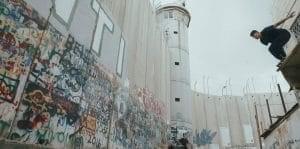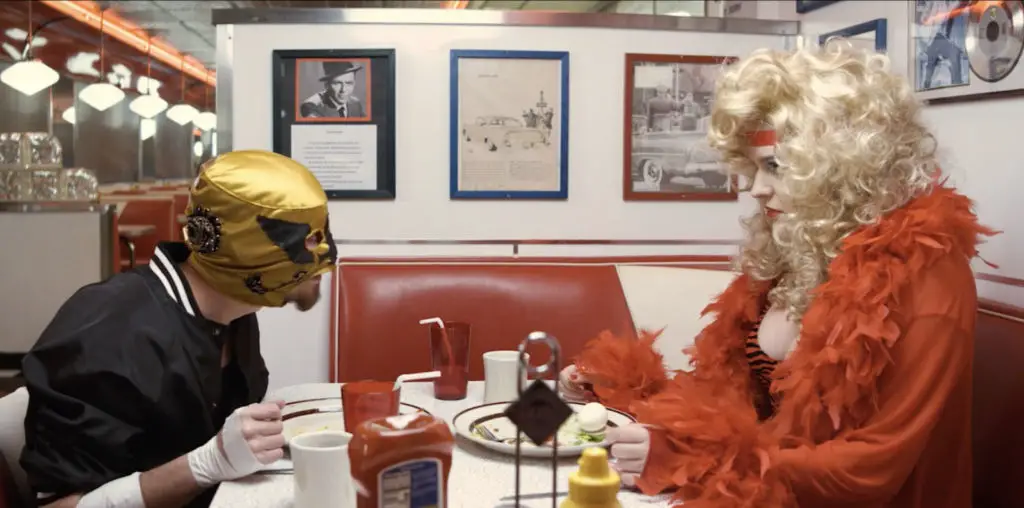
Hurdle is a 2019 documentary by Michael Rowley that follows over the course of one year, two Palestinian teachers, Sami and Mohammad, as they help their students reach their dreams and goals, all while living under military occupation.
The film starts with a protagonist atop ruins next to a border wall wondering why one would build it so tall and bitterly joking about the fact that maybe the people who built this partition thought of them as Supermen. We then see maps accompanied with dates succinctly showing the region evolution since 1948 with the construction of walls and checkpoints in occupied territories in the last 50 years or so. As a sorrowful score plays in the background, Hurdle shifts to a more contemplative or observational style focusing on Checkpoint 300 in occupied West Bank. Hundreds of men are being herded like cattle, stampeding toward a narrow corridor leading to the checkpoint at dawn. In a poetic and melancholic manner, this human wave fluctuating like a flock of birds allows us to witness first-hand the devastating effect of human-forced migrations.
“…Two Palestinian teachers, Sami and Mohammad […] try to help their students reach their dreams and find their goals, all while living under military occupation.”
We then meet Sami, a 23-year-old Palestinian and the coach of the Jerusalem Parkour Team. He teaches this discipline of freerunning or moving as fast as possible while passing obstacles and showing great acrobatic skills to the Palestinian youth. He is also a mentor and a community leader who believes that developing a sense of freedom of movement and getting rid of fear helps in overcoming not only personal obstructions but the constant oppression; as he says “in the end, we jump over obstacles.” We watch him and his students doing parkour in the ruins of the occupied Old City of Jerusalem. It looks beautiful and seems indeed liberating. “I feel like someone who had been living in a cage,” he says, but parkour sets him free or “partly free,” and he wishes every Palestinian could practice this sport so they could feel the same freedom.
Far from the usual shots of war-torn areas we see him walking down streets as he explains his motivations. Against a very fitting urban backdrop of engaged murals and street art, the youngsters are flying and showing their prowesses like acrobats using pieces of destroyed buildings or even the very same walls that restrict their movements to help their stunts.
On the other side, in the Aida Refugee Camp in the West Bank, reside Mohammad. He teaches filmmaking and storytelling to children. Since 2009 he creates exhibitions and pushes them to tell different stories from the camp by taking pictures or making films of what makes them happy. For him, it is a mean of resistance as he proclaims: “Each Palestinian can choose his way of resisting this occupation with different tools.” His goal is to document their daily lives through photography or short films and to show what people do not see in the news; the human side of things. We learn that Mohammad, like most in the region, had his “unfair” share of drama as he informs us about the harsh and brutal reality of his community having teargas or rubber bullets every morning for breakfast. At some point during an interview in his studio, we can see cameras, lights, tripods or other film gears but also a gas mask on a shelf behind him reminding us of this truth. Likewise, we realize that a nice day out for a photo shoot with children flying kites can quickly turn near-deadly as soldiers do not want kids getting too close to the border.
“His goal is to document their daily lives through photography or short films and to show what people do not see in the news; the human side of things.”
As heartbreaking and devastating as it is, the film makes us understand the Palestinian anger and hunger for freedom, but it also offers very briefly some contrasts in showing Israelis fear for they now found homes and readiness to pay a horrific price to protect or defend their dreams but also lives.
The documentary is mainly expository or observational but at times flirting with the poetic mode. Despite flowing pretty well, it struggles in maintaining a proper balance between the story and the breathing moments such as a beautifully shot scene heightened with a hint of slow-motion and local urban music, almost resembling a music video, of people doing parkour for a crowd while an intrigued rabbi is passing by. Similarly, the film oddly pauses on unrelated moments such as a bachelor party or a sudden outburst of happiness in the street where people are dancing for peace of mind, although these scenes are greatly appreciated as they are at the same time uplifting and heartily sad.
Tardily, Jihad, a parkour team member and soon-to-be lawyer with an important message, is introduced. He seems to be a major participant, but it feels non-organic and out of place. In the end, Hurdle offers new perspectives on resistance with these two men leading the next generation of Palestinian to fight oppression in a non-violent way. Hurdle merit is that it shows what happens and it tries to leave the judgment up to the undecided viewers, or at least it seeks to help us get informed and seeing this side of the story from a different angle.

Hurdle (2019) Directed by Michael Rowley.
7/10

